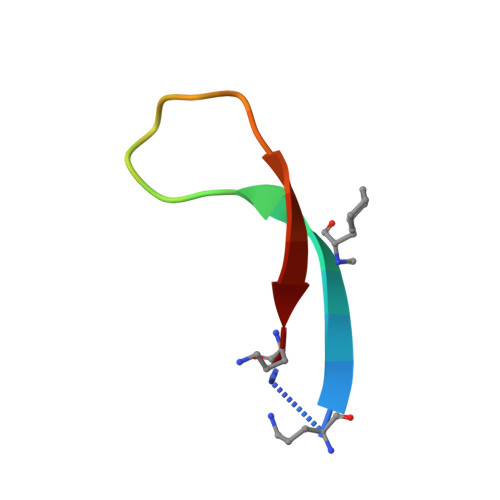Phenylalanine Mutation to Cyclohexylalanine Facilitates Triangular Trimer Formation by beta-Hairpins Derived from A beta.
Haerianardakani, S., Kreutzer, A.G., Salveson, P.J., Samdin, T.D., Guaglianone, G.E., Nowick, J.S.(2020) J Am Chem Soc 142: 20708-20716
- PubMed: 33237748
- DOI: https://doi.org/10.1021/jacs.0c09281
- Primary Citation of Related Structures:
7JXN, 7JXO - PubMed Abstract:
Oligomers of the β-amyloid peptide, Aβ, play a central role in the pathogenesis and progression of Alzheimer's disease. Trimers and higher-order oligomers composed of trimers are thought to be the most neurotoxic Aβ oligomers. To gain insights into the structure and assembly of Aβ oligomers, our laboratory has previously designed and synthesized macrocyclic peptides derived from Aβ 17-23 and Aβ 30-36 that fold to form β-hairpins and assemble to form trimers. In this study, we found that mutating Phe 20 to cyclohexylalanine (Cha) in macrocyclic Aβ-derived peptides promotes crystallization of an Aβ-derived peptide containing the Aβ 24-29 loop (peptide 3 F20Cha ) and permits elucidation of its structure and assembly by X-ray crystallography. X-ray crystallography shows that peptide 3 F20Cha forms a hexamer. X-ray crystallography and SDS-PAGE further show that trimer 4 F20Cha , a covalently stabilized trimer derived from peptide 3 F20Cha , forms a dodecamer. Size exclusion chromatography shows that trimer 4 F20Cha forms higher-order assemblies in solution. Trimer 4 F20Cha exhibits cytotoxicity against the neuroblastoma cell line SH-SY5Y. These studies demonstrate the use of the F20Cha mutation to further stabilize oligomers of Aβ-derived peptides that contain more of the native sequence and thus better mimic the oligomers formed by full-length Aβ.
Organizational Affiliation:
Department of Chemistry, University of California, Irvine, Irvine, California 92697, United States.




















